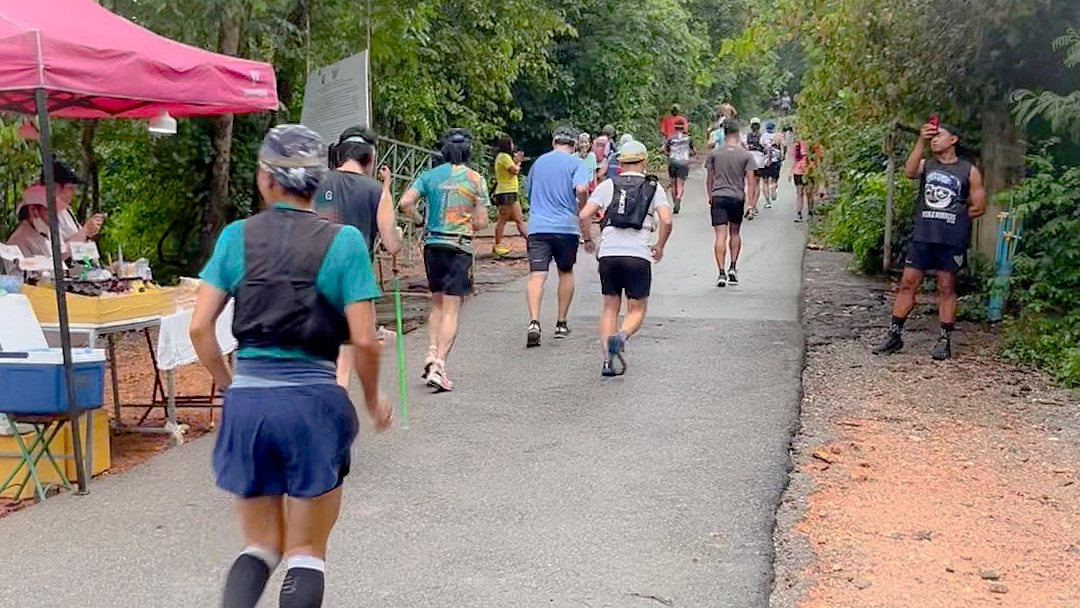We didn’t go into this race for a win. I knew she’d do well, but her performance completely stunned me. Taking home the win is a bonus. Congratulations!
The Why
So, why did we enter yesterday’s Khao Chalak 12-hour Hill Repeat competition? This challenging race served as my wife’s (Sutinee Rasp) final major training session before the Mozart Ultra race in Salzburg, Austria.
We picked this specific race because the constant uphill and downhill effort mimics what she’ll face in her race in two weeks. The Mozart Ultra is a brutal 92 km (57.17 mi) trail race in the Austrian mountains, with 4,700 m (15,420 ft) of elevation change.
We also wanted to validate her training and see if she was ready for Mozart. A strong performance here at Khao Chalak would boost her confidence on race day and show that her training is effective.—Sure, a suboptimal performance could result in the opposite, but I strongly believe in our training and considered it worth the risk.
Khao Chalak 12-hour Hill Repeat Competition
The Khao Chalak 12-hour Hill Repeat competition is precisely what it sounds like: 12 hours of non-stop up and down that mountain. The race started at 6 PM and went through the night until 6 AM the next morning.
The race route was the asphalt road leading up to the top of Khao Chalak. It’s a continuous 2.25 km (1.40 mi) climb with several seriously steep sections. Hence, one lap is about 4.5 km (2.80 mi) with a 266-meter (873 ft) elevation change, which works out to an average of 107 m (351 ft) of elevation gain per km. In contrast, the Mozart Ultra “only” has an average of 51 m (167 ft) of elevation gain per km.
The Win
My wife secured the win by repeatedly running up and down Khao Chalak an incredible 15 times in those 12 hours. Her closest competitor managed 13 laps. In the end, she had covered 67.95 km (42.22 mi) and accumulated an elevation change of 3,956 m (12,979 ft)—that’s no small feat on its own! And get this: my wife crossed the finish line looking fresh and like she could keep going for several more laps.

Damaging Downhills
Running downhill can be brutal on the legs, especially the thighs (quadriceps muscles). The muscle damage from pounding the ground (microtears) and fatigue eventually slow down a runner. How much damage those repeated impacts do depends on how tough the muscles have become from prior training. We certainly didn’t leave it up to chance and had put in the work. On top of our usual training, we did two 3-day training camps within the past two months, each with over 5,000 m (16,404 ft) of accumulated elevation gain and loss.
Like every competitor, my wife damaged her thighs during this competition by running downhill for 33.98 km (21.11 mi), half her total race distance. Remarkably, she didn’t show any signs of slowing down. Her last two laps were her fastest, both uphill and downhill! Incredible durabilityDurability refers to an athlete’s ability to maintain their physiological capacity and performance levels over extended periods of… More!
A Clear Message
My wife’s outstanding performance in the Khao Chalak 12-hour Hill Repeat competition demonstrated that she is well prepared for the Mozart Ultra in two weeks. She’s definitely good to go with that kind of durabilityDurability refers to an athlete’s ability to maintain their physiological capacity and performance levels over extended periods of… More, determination, and stamina.
The Mozart Ultra is part of the Mozart 100 by UTMB® series, featuring six distances ranging from 9 km (5.5 mi) to 120 km (74.5 mi). The races take place in Salzburg, Austria, in early June each year.
_____________
Cover photo by Gregor Rasp – The leading group of runners moments after the start of the Khao Chalak 12-hour Hill Repeat competition.

